- Joined
- Jun 11, 2006
- Messages
- 8,650
We’re excited to announce a huge advancement in our heat-treating process that will improve quality, speed, and affordability for our customers!
After extensive testing, we have developed a proprietary shielding gas process that allows us to completely eliminate the need for stainless foil on all blades—including very high-temperature alloys.
What This Means for You:
✔ Lower Heat Treating Costs – Without the added expense of stainless foil, we’re able to pass the savings on to you.
✔ Faster Turnaround Times – No more wrapping and unwrapping foil means we can process blades much more efficiently.
✔ Superior Heat Treat Quality – Our shielding process protects blades from 1400°F to 2200°F, making it possible to oil quench any alloy with full shielding.
✔ Better Results for Carbon Steels – All carbon steels will now receive gas shielding during both normalization and heat treating.
✔ Dramatically Reduced Blade Bowing – In our testing, alloys like AEB-L come out straighter even after cryo treatment, meaning minimal, if any, straightening is required.
✔ Improved Quench Plate Contact – Without foil interfering, blades now make full, even contact with quench plates, leading to more consistent results.
We’ve explored every possible shielding method we could think of — from various gases to coatings and other alternatives. Each had drawbacks in cost, effectiveness, or practicality. After what felt like years of searching, we’ve finally found the perfect solution—one that’s safer, more effective, and more cost-efficient than anything we’ve used before.
This is a game-changer for our process and our customers, and we’re excited to roll it out. Check out the pictures below to see the difference this upgrade is making!
As always, thank you for your continued support—here’s to the future of high-performance heat treating!
– Jarod Todd Heat Treating
Disclaimer: The blade designs shown in the images are the property of our customers. They are shared here with permission to showcase the results of our heat-treating process. Please respect the intellectual property of the makers and refrain from copying or reproducing their work.
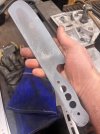
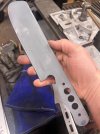
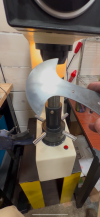
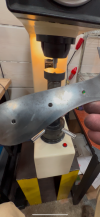

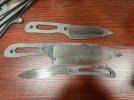

After extensive testing, we have developed a proprietary shielding gas process that allows us to completely eliminate the need for stainless foil on all blades—including very high-temperature alloys.
What This Means for You:
✔ Lower Heat Treating Costs – Without the added expense of stainless foil, we’re able to pass the savings on to you.
✔ Faster Turnaround Times – No more wrapping and unwrapping foil means we can process blades much more efficiently.
✔ Superior Heat Treat Quality – Our shielding process protects blades from 1400°F to 2200°F, making it possible to oil quench any alloy with full shielding.
✔ Better Results for Carbon Steels – All carbon steels will now receive gas shielding during both normalization and heat treating.
✔ Dramatically Reduced Blade Bowing – In our testing, alloys like AEB-L come out straighter even after cryo treatment, meaning minimal, if any, straightening is required.
✔ Improved Quench Plate Contact – Without foil interfering, blades now make full, even contact with quench plates, leading to more consistent results.
We’ve explored every possible shielding method we could think of — from various gases to coatings and other alternatives. Each had drawbacks in cost, effectiveness, or practicality. After what felt like years of searching, we’ve finally found the perfect solution—one that’s safer, more effective, and more cost-efficient than anything we’ve used before.
This is a game-changer for our process and our customers, and we’re excited to roll it out. Check out the pictures below to see the difference this upgrade is making!
As always, thank you for your continued support—here’s to the future of high-performance heat treating!
– Jarod Todd Heat Treating
Disclaimer: The blade designs shown in the images are the property of our customers. They are shared here with permission to showcase the results of our heat-treating process. Please respect the intellectual property of the makers and refrain from copying or reproducing their work.







